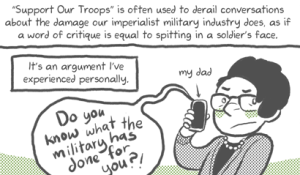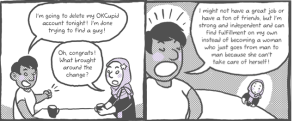
Two young people smiling as one gives a piggyback ride to the other.
All of us – no matter how easy-going or “low-maintenance” – have boundaries. We have boundaries around things we won’t do sexually, ways we don’t want to be spoken to, activities we don’t want to do with friends, projects we don’t have the time or energy for, tasks we don’t feel comfortable doing at work, roles we won’t take on with people.
But once a friend responded to one of my many articles about setting boundaries with a question that stumped me: What if we don’t know what our boundaries are?
Unless you’ve been through it, that might sound silly to you. Sure, setting boundaries can be hard for anyone because we all worry about being disliked or pushing people we like away. But how can you not even know where your own boundaries are?
Pretty easily – if you, like most women and many other marginalized people, were raised to never put yourself first.
When I think back to my childhood and adolescence, one of the patterns that stands out is how often I was told that I don’t feel the way I say I feel. This is a form of gaslighting because it denies someone’s own reality.
When I would say that something hurt my feelings, others – kids and adults both – would often say, “Come on, it wasn’t a big deal.” When I said that a guy made me uncomfortable, others would rush in to say, “But he’s such a nice guy.” When I said that I didn’t want to eat a certain food or play a certain game, my parents or friends would say, “But it’s good for you,” or “But you’ll have fun if you try it,” and other comments that were intended to override my own stated preferences.
Enough of that and anyone would lose track of what it is they actually want. If you’re used to your boundaries not being respected, forgetting that those boundaries ever existed can be an adaptive tactic. It’s easier than fighting every step of the way, than knowing consciously that people you love are ignoring your needs.
The problem is that becoming ignorant of your own boundaries doesn’t actually make them go away.
They’re still with you – it’s that twinge of discomfort you feel before agreeing with your partner, that nameless and inexplicable fear at the thought of trying something you don’t even realize you don’t want to try (and have the right not to!), that embarrassing anxiety about going on a date that maybe you don’t actually want at all.
If you don’t know what your boundaries are, not even the kindest, most progressive, most consent-aware friends and partners can respect those boundaries, because you won’t be able to communicate them. Healing from that subtle but harmful gaslighting so many of us grew up with takes time and effort. Here are some ways to start to figure out what your boundaries are.
1. Reflect on Past Experiences
The past is the past, and you can’t change it. But reflecting on things that have happened in the past now that you’re more removed from those situations can be a good way to start to learn where your natural boundaries are.
When faced with stressful situations, many of us revert to our instincts. But instincts don’t just refer to what we’re born with – instincts can develop through socialization.
For many people who have trouble recognizing their own boundaries, the instinct they learn early on is to accommodate others rather than themselves. That’s how we start to lose touch with ourselves and what we want.
Later on, when you’ve gained some distance from a given experience, it can be easier to think past those instincts. What bothered you about what happened? What do you wish had happened instead? What do you wish you would’ve said or done?
For instance, I’ve often looked back on my early sexual experiences and realized that I never wanted them at all. That’s not something I was aware of at that moment. But now, in a safer and more comfortable place, I’m able to acknowledge that I didn’t want those things to happen and that I wish I’d been able to speak up. In most of those cases, it turns out that my boundary is that I need someone to ask me directly before sex happens. That gives me the space to figure out if I really want it or not, and say so.
If you are able to access professional mental healthcare, a therapist can be really helpful with this type of work. You don’t have to have a Diagnosable Mental Illness™ to benefit from their help. Therapy is also a great place to practice setting boundaries.
2. Practice Mindfulness
Unfortunately, this really useful practice has become a bit of a buzzword lately and is being appropriated for things like keeping employees content with crappy work conditions and fixing every human problem ever. Many people also use it as part of an appropriative approach to Buddhism. So it might be hard to take it seriously. But at its core, mindfulness just means paying attention to how you’re feeling, without judging it or trying to change it right away.
That last part is particularly important, because those of us who have trouble figuring out where our boundaries lie often have that trouble because we try to stop ourselves from feeling uncomfortable the moment we realize we feel uncomfortable.
What if you simply noticed how you felt… without doing anything about it?
That means that stressful social situations might not be the best time to start trying to learn how to practice mindfulness. In fact, since it can be easier to really notice how your body feels than how your mind feels, it might help to start by focusing on physical sensations.
One of my favorite mindfulness exercises to teach as an introduction to the practice is called a body scan. It’s exactly what it sounds like: you slowly scan your body, going from your feet up through your legs, torso, arms, neck, and head, paying attention to how each specific part feels. As you get better at it, you can focus on more and more specific parts of your body.
Remember not to judge how you’re feeling or try to change it. If you notice pain or discomfort, practice saying to yourself, “Huh, I notice that my left leg hurts,” and then moving on to the next part of your body. The point isn’t that the pain is okay, or that you should never do anything about it. The point is that right now, your focus is simply noticing.
If you want to try doing a body scan exercise, here’s a good one to start with. If you prefer text, here’s one that’s a little more in-depth. Different wording works best for different people, so don’t hesitate to search around online and try different versions.
You can start practicing mindfulness when you’re calm and alone, but as you get better at focusing on it, you can do it when you’re with people, when you’re stressed or in pain, or both. Notice how interpersonal stress and conflict feels in your body. Notice at what point in a conversation your muscles start to tense up. Notice what makes your stomach churn.
Establishing that sort of connection with your own body is valuable in and of itself, but it’ll also help you do the same with your mental state. Practice checking in with yourself during various points in the day. How is whatever’s going on right now making you feel?
That’s how you’re going to learn where your boundaries are. But before you can do that, you have to practice noticing without judging or trying to change. Let yourself feel that discomfort rather than immediately making it go away by doing what the person is asking of you. Maybe that discomfort is there because it’s time to set a boundary.
3. Try Journaling
Earlier I suggested reflecting on past experiences as a way to figure out where you might’ve wanted to set boundaries. However, it can be hard to remember the specifics of situations that happened long ago and are uncomfortable to think about – sometimes we forget details because we don’t really want to remember.
Journaling can help bridge that gap. It might help to write about challenging interpersonal interactions soon after they happen – as soon as possible, in fact. Although it might be tempting to just try not to think about it and move on with your day, try taking the time to journal about what happened and how you felt.
In particular, ask yourself these questions: What happened? How did you feel? What do you wish had happened differently? What do you wish you could’ve said or done?
Writing is useful because of the way it makes you reflect on things deliberately – writing is slower than speaking. It can also be helpful to go back and reread past journal entries as you try to draw connections between situations and figure out what it is that you need to set boundaries about.
But if the idea of journaling really doesn’t resonate with you, you can also try making an audio recording or talking to a supportive friend – just make sure that your friend knows that their role here is not to provide advice, but to encourage you to talk things out.
Ultimately it’s not about whether or not you write anything down. It’s about asking yourself the right questions, and doing your best to answer them honestly.
4. Learn About Other People’s Boundaries and How They’ve Set Them
Although all of the suggestions I just gave have been helpful for me in learning where my boundaries are, nothing helped as much as simply reading about boundaries.
When I read books, blogs, and articles that deal with boundaries, my immediate response is often this: “Wait, that’s a boundary I get to set? I can do that?!”
That’s why advice columns like Captain Awkward have been so helpful for me. A lot of the people writing to her for advice have experiences similar to mine, and reading about their needs and seeing Captain Awkward affirm those needs and help them set those boundaries has given me “permission” to set my own.
Of course, you don’t need permission from anyone to set boundaries. But sometimes it feels that way, and until you hear about someone else’s experience with a particular issue, you may not even realize that that’s a boundary you need to set.
Some other resources that have helped me include the blog Real Social Skills, the sex education site Scarleteen, and advice columns from Autostraddle (a website for and by queer women and nonbinary folks).
If you feel comfortable, you can also ask your friends to tell you about boundaries they’ve had to set with others in their lives. You may have had similar experiences, and knowing their boundaries can help you figure out your own. Remember, though, that everyone’s experiences are unique, so it’s okay if your boundaries aren’t the same as your friends’.
Most of all, remember to try to be patient with yourself. Not knowing where your boundaries are isn’t a personal failing; it’s a natural consequence of a society that teaches marginalized people to ignore their own feelings, needs, and preferences.
There’s nothing wrong with you for learning the lessons you were taught, and although unlearning them won’t be easy, it’s not impossible. You may not get there right away, but with time you can learn to get back in touch with yourself and your boundaries.
[do_widget id=’text-101′]
Miri Mogilevsky is a Contributing Writer for Everyday Feminism and a recently graduated with a Masters in Social Work and is starting a career as a counselor in Columbus, Ohio. She loves reading, writing, and learning about psychology, social justice, and sexuality, and is working on her cat photography skills. Miri writes a blog called Brute Reason, rants on Tumblr, and occasionally even tweets @sondosia.
Search our 3000+ articles!
Read our articles about:
Our online racial justice training
Used by hundreds of universities, non-profits, and businesses.
Click to learn more




















